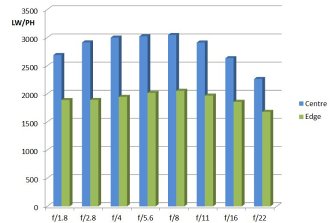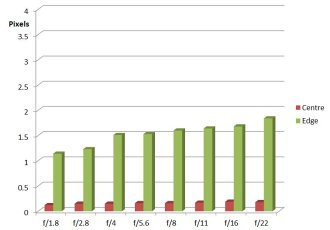Samyang 20mm f/1.8 ED AS UMC Review
Samyang 20mm f/1.8 ED AS UMC Performance
The central performance of the Samyang 20mm f/1.8 ED AS UMC lens in terms of sharpness is exceptional. Open aperture is excellent and apertures from f/2.8 through to f/16 offer outstanding sharpness. Diffraction eventually hits at f/22 but here the result is still very good.
The full frame edges are not quite in the same league, but do give a very good level of sharpness from f/1.8 to f/16. Only at f/22 do we see this dip to a softer but still good performance. It should also be borne in mind that lenses such as this are not intended for photographing test charts at close distances. Despite this caveat, the lens acquits itself very well indeed.
The optimum aperture for the whole field is f/8, but for an ultra-wide lens this is overall a really excellent result. High-quality results can be expected from full frame cameras, but obviously smaller formats will have the advantage of a more even balance between centre and edge.
How to read our charts
The blue column represents readings from the centre of the picture frame at the various apertures and the green is from the edges.The scale on the left side is an indication of actual image resolution as LW/PH and is described in detail above. The taller the column, the better the lens performance.
For this review, the lens was tested on a Canon EOS 6D using Imatest.
There is virtually no CA (Chromatic Aberration) at the centre, but, unsurprisingly, the edges do show some fringing. This can easily be corrected in software.
How to read our charts
Chromatic aberration is the lens' inability to focus on the sensor or film all colours of visible light at the same point. Severe chromatic aberration gives a noticeable fringing or a halo effect around sharp edges within the picture. It can be cured in software.Apochromatic lenses have special lens elements (aspheric, extra-low dispersion etc) to minimise the problem, hence they usually cost more.
For this review, the lens was tested on a Canon EOS 6D using Imatest.
Ultra-wide lenses are generally quite susceptible to flare but in this case, the lens is remarkably flare free. It is possible to induce some artefacts, but in most situations flare is not a problem.
We would normally anticipate some barrel distortion in a 20mm lens design, and this is no exception. However, the -2.26% barrel distortion measured is really quite moderate, and if needed, perhaps for critical architectural shots, then it can be corrected in software.
With only 7 blades to the diaphragm the aperture is not particularly circular, so in this respect, the out of focus highlights take on the traditional hard-edged shape. The bokeh is good, but not the exceptional smoothness that some lenses have. The effect is slightly “busy” but certainly not so much so as to be unpleasant.
Value For Money
The Samyang 20mm f/1.8 ED AS UMC lens is priced at £430. There are numerous alternatives, although few at f/1.8. Samyang offers another manual focus lens, the 20mm T1.9 VD SLR ED AS IF UMC, at £479.
Sigma has a brighter AF offering, the 20mm f/1.4 DG HSM Art at £629. Nikon has the 20mm f/1.8 AF-S Nikkor G ED at £649. Canon users have just one slower lens, the Canon EF 20mm f/2.8 USM, priced at £409.
Given that it is a manual focus lens, the new Samyang might be seen as fair value. The Nikon AF alternative, for example, costs a good £200 more.
For more options have a look at the Top 10 Best Samyang lenses or have a look at the Top 15 Wide-angle Lenses.
Add your message
Please login here or if you've not registered, you can register here. Registering is safe, quick and free.
photodo Stats
428 MTF tests
74 in-depth photodo reviews
100+ users join each day
Help the lens community by reviewing or rating a lens today via our lens search
Latest Lens Reviews
- Chinon 28mm f/2.8 Vintage Lens Review
- Canon EF 70-200mm f/4L IS II USM Lens Review
- Samyang AF 85mm f/1.4 EF Review
- Sigma 70mm f/2.8 DG Macro Art Review
- Samyang AF 24mm f/2.8 FE Review
- Meike 50mm f/1.7 Review
- Tamron 70-210mm f/4 Di VC USD Review
- Lensbaby Burnside 35mm f/2.8 Review
- Asahi Super Takumar 50mm f/1.4 Review
- Asahi Super-Multi-Coated Takumar 135mm f/3.5 Review


